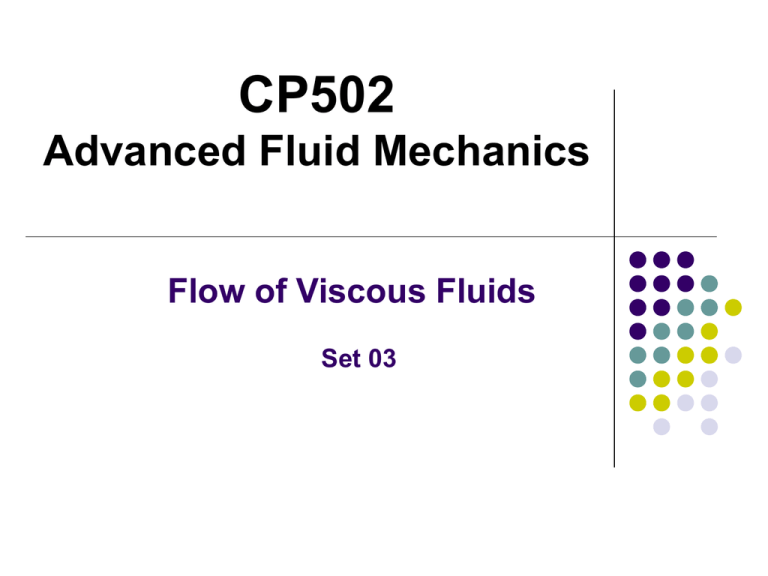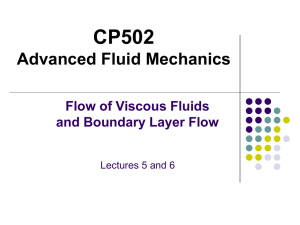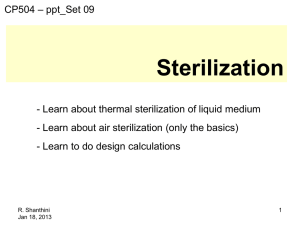ViscousFlow_Set03
advertisement

CP502 Advanced Fluid Mechanics Flow of Viscous Fluids Set 03 Continuity and Navier-Stokes equations for incompressible flow of Newtonian fluid υ R. Shanthini 05 April 2012 ρ Steady, fully developed, laminar, incompressible flow of a Newtonian fluid down an inclined plane under gravity Exercise 1: Show that, for steady, fully developed laminar flow down the slope (shown in the figure), the Navier-Stokes equations reduces to z d 2u g sin 2 dy θ where u is the velocity in the x-direction, ρ is the density, μ is the dynamic viscosity, g is acceleration due to gravity, and θ is the angle of the plane to the horizontal. Solve the above equation to obtain the velocity profile u and obtain the expression for the volumetric flow rate for a flowing film of thickness h. Exercise 2: If there is another solid boundary instead of the free-surface at y = h and the flow occurs with no pressure gradient, what will be the volumetric flow rate? R. Shanthini 05 April 2012 Step 1: Choose the equation to describe the flow Navier-Stokes equation is already chosen since the system considered is incompressible flow of a Newtonian fluid. Step 2: Choose the coordinate system Cartesian coordinate system is already chosen. z Step 3: Decide upon the functional dependence of the velocity components x direction: y direction: z direction: u function(t, x, y, z) v function(t, x, y, z) w function(t, x, y, z) } θ (1) Steady, fully developed flow and therefore no change in time and in the flow direction. Channel is not bounded in the z-direction and therefore nothing happens in the z-direction. R. Shanthini 05 April 2012 x direction: u function( y ) y direction: z direction: v function( y ) w0 } (2) Step 4: Use the continuity equation in Cartesian coordinates v 0 y u v w 0 x y z v constant or Flow geometry shows that vv can not be a constant, and therefore we choose v0 v z v0 R. Shanthini 05 April 2012 θ The functional dependence of the velocity components therefore reduces to x direction: u = function of (y) (3) y direction: v=0 z direction: w=0 Step 5: Using the N-S equation, we get x - component: y - component: z - component: R. Shanthini 05 April 2012 } N-S equation therefore reduces to x - component: y - component: z - component: p 2u 2 g x 0 x y p g y 0 y p g z 0 z z θ No applied pressure gradient to drive the flow. Flow is driven by gravity alone. Therefore, we get x - component: y - component: z - component: R. Shanthini 05 April 2012 2u gx 2 y d 2u g sin 2 dy (4) p g y g cos y p 0 z p is not a function of z What was asked to be derived in Exercise 1 Steady, fully developed, laminar, incompressible flow of a Newtonian fluid down an inclined plane under gravity Exercise 1: Show that, for steady, fully developed laminar flow down the slope (shown in the figure), the Navier-Stokes equation reduces to d 2u g sin 2 dy √done z θ where u is the velocity in the x-direction, ρ is the density, μ is the dynamic viscosity, g is acceleration due to gravity, and θ is the angle of the plane to the horizontal. Solve the above equation to obtain the velocity profile u and obtain the expression for the volumetric flow rate for a flowing film of thickness h. Exercise 2: If there is another solid boundary instead of the free-surface at y = h and the flow occurs with no pressure gradient, what will be the volumetric flow rate? R. Shanthini 05 April 2012 d 2u g sin 2 dy (4) z Equation (4) is a second order equation in u with respect to y. Therefore, we require two boundary conditions (BC) of u with respect to y. BC 1: At y = 0, u = 0 BC 2: At y = h, du 0 h (no-slip boundary condition) θ (free-surface boundary condition) dy Integrating equation (4), we get Applying BC 2, we get du g sin y A dy g A sin h Combining equations (5) and (6), we get R. Shanthini 05 April 2012 (5) (6) du g sin h y dy (7) z h θ g y2 sin hy B Integrating equation (7), we get u 2 Applying BC 1, we get B=0 Combining equations (8) and (9), we get R. Shanthini 05 April 2012 (8) (9) g y2 u sin hy 2 (10) g y2 u sin hy 2 (10) z Volumetric flow rate through one unit width fluid film along the z-direction is given by h h Q u dy θ 0 g y2 Q sin hy dy 2 0 h h g y h 3 h 3 gh3 y g Q sin h sin sin 6 0 3 2 2 6 2 R. Shanthini 05 April 2012 3 (11) Steady, fully developed, laminar, incompressible flow of a Newtonian fluid down an inclined plane under gravity Exercise 1: Show that, for steady, fully developed laminar flow down the slope (shown in the figure), the Navier-Stokes equation reduces to d 2u g sin 2 dy √done z θ where u is the velocity in the x-direction, ρ is the density, μ is the dynamic viscosity, g is acceleration due to gravity, and θ is the angle of the plane to the horizontal. Solve the above equation to obtain the velocity profile u and obtain the expression for the volumetric flow rate for a flowing film of thickness h. Exercise 2: √done If there is another solid boundary instead of the free-surface at y = h and the flow occurs with no pressure gradient, what will be the volumetric flow rate? R. Shanthini 05 April 2012 d 2u g sin 2 dy (4) Equation does not change. BCs change. z BC 1: At y = 0, u = 0 (no-slip boundary condition) h BC 2: At y = h, du 0 (free-surface boundary condition) dy u=0 θ (no-slip boundary condition) Integrating equation (4), we get du g sin y A dy g y2 Integrating equation (12), we get u sin Ay B 2 Applying the BCs in (13), we get B = 0 and R. Shanthini 05 April 2012 g h A sin 2 (12) (13) Therefore, equation (13) becomes g hy y 2 u sin 2 2 (14) Volumetric flow rate through one unit width fluid film along the z-direction is given by z h h θ Q u dy 0 g hy y 2 Q sin dy 2 2 0 h h g hy h 3 h 3 gh3 y g Q sin sin sin 6 0 4 4 6 12 2 R. Shanthini 05 April 2012 3 (15) Summary of Exercises 1 and 2 Gravity flow through two planes Free surface gravity flow z z h h θ g y2 u sin hy 2 gh3 Q sin 3 θ (10) (11) g hy y 2 u sin 2 2 gh3 Q sin 12 (14) (15) Why the volumetric flow rate of the free surface gravity flow is R. Shanthini 4 times larger than the gravity flow through two planes? 05 April 2012 Any clarification? R. Shanthini 05 April 2012 Steady, fully developed, laminar, incompressible flow of a Newtonian fluid down a vertical plane under gravity Exercise 3: A viscous film of liquid draining down the side of a wide vertical wall is shown in the figure. At some distance down the wall, the film approaches steady conditions with fully developed flow. The thickness of the film is h. Assuming that the atmosphere offers no shear resistance to the motion of the film, obtain an expression for the velocity distribution across the film and show that 3Q h g (1 / 3 ) where ν is the kinematic viscosity of the liquid, Q is the volumetric flow rate per unit width of the plate and g is acceleration due to gravity. R. Shanthini 05 April 2012 y h Workout Exercise 3 in 5 minutes! R. Shanthini 05 April 2012 Oil Skimmer Example An oil skimmer uses a 5 m wide x 6 m long moving belt above a fixed platform ( = 60º) to skim oil off of rivers (T = 10ºC). The belt travels at 3 m/s. The distance between the belt and the fixed platform is 2 mm. The belt discharges into an open container on the ship. The fluid is actually a mixture of oil and water. To simplify the analysis, assume crude oil dominates. Find the discharge and the power required to move the belt. = 860 kg/m3 = 1x10-2 Ns/m2 U l R. Shanthini 05 April 2012 30º g h Oil Skimmer Discharge = ? N-S equation reduces to p 2u x - component: 2 g x 0 x y p y - component: g y 0 y p z - component: g z 0 z No applied pressure gradient to drive the flow. Flow is driven by gravity alone. Therefore, we get x - component: y - component: zR. -Shanthini component: 05 April 2012 2u gx 2 y g sin 2 dy d 2u p g y g cos y p 0 z p is not a function of z (16) g sin 2 dy d 2u BC 1: At y = 0, u = 0 BC 2: At y = h, du 0 (16) Sign changes in the equation (no-slip boundary condition) (free-surface boundary condition) dy u=U (no-slip boundary condition) du g sin y A Integrating equation (16), we get dy Integrating equation (17), we get g y2 u sin Ay B 2 Applying the BCs in (18), we get B = 0 and R. Shanthini 05 April 2012 (17) g h U A sin 2 h (18) Therefore, equation (18) becomes g hy y 2 U u sin y 2 h 2 (19) Volumetric flow rate through one unit width fluid film along the z-direction is given by h g hy y 2 U Q u dy sin dy y dy 2 h 2 0 0 0 h h gh3 Uh Q sin 12 2 Q (20) (860 kg/m3 )(9.806 m/s2 )(0.002m)3 (12)(10 2 Ns/m2 ) (3 m/s)(0.002 m) sin(30 ) 2 o Q 0.000281m2/s 0.003m2/s 0.0027m2/s R. Shanthini 05 April 2012 per unit width of the belt Q (0.0027m2 /s)(5 m) 0.0135m3/s Oil Skimmer Power Requirements = ? How do we get the power requirement? Power = Force x Velocity [N·m/s] What is the force acting on the belt? Shear force (t · L · W) Equation for shear? t = (du/dy) R. Shanthini 05 April 2012 Evaluate t = (du/dy) at the moving belt g hy y 2 U u sin y 2 h 2 (19) g h du U sin y dy h 2 At the moving belt du h U g sin 2 h dy at y h t at thebelt 2 2 0 . 002 m ( 10 Ns/m )(3 m/s) t at thebelt (860kg/m3 )(9.806m/s2 )(0.5) 2 (0.002 m) t at thebelt 4.21 kg/m.s2 15 kg/m.s2 19.21 kg/m.s2 = 19.21 N/m2 R. Shanthini 05 April 2012 Power = shear force at the belt * L * W * U = (19.21 N/m2) (6 m) (5 m) (3 m/s) = 1.73 kW To reduce the power requirement, decrease the shear force R. Shanthini 05 April 2012 d 2 u V du dy2 dy Steady, fully developed, laminar, incompressible flow of a Newtonian fluid over a porous plate sucking the fluid Exercise 4: An incompressible, viscous fluid (of kinematic viscosity ν) flows between two straight walls at a distance h apart. One wall is moving at a constant velocity U in x-direction while the other is at rest as shown in the figure. The flow is caused by the movement of the wall. The walls are porous and a steady uniform flow is imposed across the walls to create a constant velocity V through the walls. Assuming fully developed flow, show that the velocity profile is given by u 1 exp(Vy / ) U 1 exp(Vh / ) Also, show that (i) u approaches Uy/h for small V, and (ii) u approaches U exp V h y / for very large Vh/ν. R. Shanthini 05 April 2012 V U z h U Step 1: Choose the equation to describe the flow done Step 2: Choose the coordinate system done Step 3: Decide upon the functional dependence of the velocity components Steady, fully developed flow and therefore no change in time and in the flow direction. Channel is not bounded in the z-direction and therefore nothing happens in the z-direction. x direction: u function( y ) y direction: z direction: v function( y ) w0 } (1) Step 4: Use the continuity equation in Cartesian coordinates u v w 0 x y z v 0 y V v constant or v 0 R. Shanthini 05 April 2012 v V U z h U The functional dependence of the velocity components therefore reduces to x direction: u = function of (y) (2) y direction: v=V z direction: w=0 Step 5: Using the N-S equation, we get x - component: y - component: z - component: R. Shanthini 05 April 2012 } N-S equation therefore reduces to x - component: y - component: z - component: u p 2u V 2 y x y p g y p 0 z No applied pressure gradient to drive the flow. Flow is caused by the movement of the wall. Therefore, we get x - component: d 2 u V du 2 dy dy (3) V U R. Shanthini 05 April 2012 z h U d 2 u V du du V where dy2 dy dy (3) Equation (3) is a second order equation in u with respect to y. Therefore, we require two boundary conditions (BC) of u with respect to y. BC 1: At y = 0, u = 0 (no-slip boundary condition) BC 2: At y = h, u = U (no-slip boundary condition) Integrating equation (3), we get du exp(y A) dy Integrating equation (4), we get u 1 (4) exp( y A) B (5) Applying the BCs in equation (5), we get 0 R. Shanthini 05 April 2012 U 1 1 exp( A) B exp( h A) B (6) (7) From equations (6) and (7), we get exp(A) U exp(h) 1 B 1 exp(A) U exp(h) 1 Substituting the above in equation (5), we get u U U 1 exp(y ) exp(y ) U exp(h) 1 exp(h) 1 1 exp(h) u 1 exp(Vy / ) U 1 exp(Vh / ) (8) V U R. Shanthini 05 April 2012 z h U u 1 exp(Vy / ) U 1 exp(Vh / ) (8) (i) For small V, expand exp(Vy/ν) and exp(Vh/ν) using Taylor series as follows: (Vy / ) 2 (Vy / ) 2 1 1 (Vy / ) 2! 3! U u (Vh / ) 2 (Vh / ) 2 1 1 (Vh / ) 2! 3! For small V, we can ignore the terms with power. We then get u Vy / y U U Vh / h V U Could you recognize the above profile? R. Shanthini 05 April 2012 z h U u 1 exp(Vy / ) U 1 exp(Vh / ) (8) For very large Vh/ν, exp(Vh/ν) goes to infinity. Therefore. Divide equation (8) by exp(Vh/ν). We then get u exp(Vh / ) exp(Vy / ) exp(Vh / ) exp(Vh / ) 1 For very large Vh/ν, exp(-Vh/ν) goes to zero. Therefore, we get exp(Vy / ) exp(Vh / ) u U ( 1) V u U exp V h y / R. Shanthini 05 April 2012 U z h U










